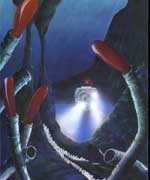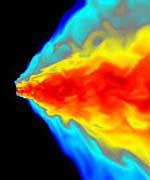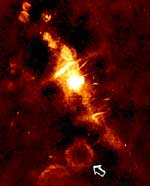
Image credit: Woods Hole Oceanographic
A lot of things had to go well for life to come about. If you go way back, it all begins with a Big Bang universe giving birth to space and time. In that early universe light echoed about, slowed in vibrancy, the primordial elements coalesced then condensed into a first generation of massive breeder stars. After warming to the notion (by gravitational compression), primordial matter began fusing in stellar cores and a lesser form of light moved outward to warm and illuminate a young and potentially ever-expanding Universe.
More time and more space saw many of those early blue stars implode (after living very short lives). Subsequent explosions spewed vast quantities of heavier – non-primordial – atoms into space. Out of this rich cosmic endowment new stars formed – many with planetary attendants. Because such second and third generation suns are less massive than their progenitors, they burn slower, cooler, and much, much longer – something essential to the kind of benignly consistent energy levels needed to make organic life possible.
Although breeder stars formed within a few hundred million years of the Big Bang, life here on Earth took its time. Our Sun – a third generation star of modest mass – formed some nine-billion years later. Life-forms developed a little more than one billion years after that. As this occurred, molecules combined to form organic compounds which – under suitable conditions – joined together as amino acids, proteins, and cells. During all this one layer of complexity was added to another and creatures became ever more perceptive of the world around them. Eventually – after more billions of years – vision developed. And vision – added to an subjective sense of awareness – made it possible for the Universe to look back at itself.
Empirical research into the fundamentals of life shows that a concoction of well-chosen elements (hydrogen, carbon, oxygen, & nitrogen) exposed to non-ionizing ultraviolet radiation forms amino acids. Amino acids themselves have a remarkable capacity to chain together into proteins. And proteins have a rather “protean” ability to give shape and behavior to cells. It is now considered entirely possible that the very first amino acids took form in space1 – shielded from harder forms of radiation within vast clouds comprised of primordial and star-stuff material. For this reason, life may be an ubiquitous phenomenon simply awaiting only certain favorable conditions to take root and grow into a wide variety of forms.
Currently, exobiologists believe that liquid water is essential to the formation and multiplication of organic life. Water is an extraordinary substance. As a mild solvent, water enables other molecules to dissociate and mix. Meanwhile it is very stable and is transparent to visible light – something useful if biotics are to derive energy directly from sunlight. Finally water holds temperature well, carries off excess heat through vaporization, and floats when cooled to solidify as ice.
According to NASA exobiologist Andrew Pohorille, “Water brings organic molecules together and permits organization into structures that ultimately became cells.” In so doing, water acts in an unparalleled matrix enabling organic molecules to form self-organizing structures. Andrew cites one property uniquely associated with water that makes self-organization and growth possible: “The hydrophobic effect is responsible for the fact that water and oil don’t mix, soaps and detergents ‘capture’ oily dirt during washing in water and for a vast number of other phenomena. More generally, hydrophobic effect is responsible for segregating nonpolar (oily) molecules or parts of molecules from water, so they can stick together even though they are not bonded. In biology these are precisely the interactions responsible for the formation of membranous cell walls and for folding proteins into functional structures.”
For water to take the liquid state, it must remain in a relatively narrow range of temperatures and pressures. Because of this only a certain few well-placed planets – and possibly a handful of large moons are favored with the conditions needed to let life live. In many cases it all comes down to a form of celestial real estate – location, location, location…
Early life on Earth was very simple in form and behavior. Though cellular, they lacked a central nucleus (prokaryotic) and other sub-structures (organelles). Lacking a nucleus such cells reproduced asexually. These anaerobes subsisted primarily by creating (anabolizing) methane gas from hydrogen and carbon-dioxide. They liked heat – and there was plenty of it to go around!
The fact that life developed on Earth should not be as surprising as one might think. Life is now considered far more robust than once imagined. Even now hydrothermal vents deep in the ocean eject near-boiling water. Adjacent to such vents life – in the form of giant tube worms and clams – flourishes. Deep under the surface of the Earth mineral-metabolizing anaerobic bacteria are found. Such conditions were thought impossible throughout most of the 20th century. Life seems to spring up under even the harshest of conditions.
As life forms advanced on our world, cells developed organelles – some by incorporating lesser, more specialized cells into their structures. The planet cooled, its atmosphere clarified and sunlight played upon the oceans. Primitive bacteria arose that fixed energy from sunlight as food. Some remained prokaryotic while others developed a nucleus (eukaryotic). These primitive bacteria increased the oxygen content of the Earth’s atmosphere. All this transpired some 2 billion years ago and was essential to support the quality and quantity of life currently populating “the Blue Planet”.
Originally the atmosphere consisted of less than 1% oxygen – but as levels increased, bacteria-eating life-forms adapted to synthesize water from oxygen and hydrogen. This released far more energy than methane metabolism is capable of. The controlled synthesis of water was a huge accomplishment for life. Consider the high school chemistry lab experiments where hydrogen and oxygen gas are combined, heated then explode. Primitive life forms had to learn to handle this very volatile stuff in a far safer manner – putting phosphorus to task in the conversion of ADP to ATP and back again.
Later – roughly 1 billion years ago – the simplest multi-cellular creatures took form. This occurred as cells came together for the common good. But such creatures were simple colonies. Each cell was fully self-contained and took care of its own needs. All they required was constant exposure to the warm broth of the early oceans to acquire nutrients and eliminate wastes.
The next great step in the evolution of life2
came as specialized cell tissue types developed. Muscle, nerve, epidermis and cartilage advanced the development of the many complex life-forms now populating our planet – from flowering plant to budding young astronomer! But that very first organized creature may very well have been a worm (annelid) burrowing through the marine slime of some 700 million years ago. Lacking eyes and a central nervous system it possessed only the capacity to touch and to taste. But now life had the capacity to differentiate and specialize. The creature itself became the ocean…
With the advent of well-organized creatures the pace of life quickened:
By 500 MYA, the first vertebrates evolved. These were probably eel-like creatures lacking in sight but sensitive to chemical – and possibly electrical – changes in their environments.
By 450 MYA, the first animals (insects) joined rooting plants on land.
Some 400 MYA the first vertebrates climbed out of the sea. This may have been an amphibious fish subsisting on insects and plant-life along the shore.
By 350 MYA – the first “iguana-like” reptiles emerged. These possessed strong, hard, jaws in a one-piece skull. As they grew larger, such reptiles lightened their skulls by adding orifices (beyond simple eye sockets). Before dinosaurs dominated the earth, crocodiles, turtles, and pterasaurs (flying reptiles) preceded them.
Primitive mammals go back almost 220MY. Most of these creatures were small and rodent-like. Later versions developed the placenta – but earlier species simply hatched eggs internally. All mammals of course, are warm-blooded and because of this must eat voraciously to maintain body temperature – especially on cold windy nights tracking down faint galaxies along the Eridanus river…
Like mammals, warm-blooded birds require more food than reptiles – but like reptiles – laid eggs. Not a bad idea for a creature of flight! Today celestial birds fly (such as late summer’s Cygnus the Swan and Aquila the Eagle) because real birds took wing some 150 MYA.
The earliest primates existed even during the time of the extinction of the dinosaurs Strong evidence supports the idea that the dinosaurs themselves passed as a group after an asteroid – or comet – impacted the Yucatan peninsula of the United States of Mexico. After this catastrophic event temperatures fell as a “non-nuclear” winter descended. Under such conditions food was spare, but warm-bloodedness came into its own. It wasn?t long however before one type of a “gigantism” soon replaced another – mammals themselves grew to extraordinary sizes and the largest developed in the womb of the sea and now take the form of the great whales.
The end of the “terrible lizards” was not the first mass-extinction of life – four previous die-offs had preceded it. Today, aware of the potential for other such cataclysmic impacts, some of the world’s astronomers keep an eye on near-earth orbiting chunks of debris left over from the formation of the solar system. The smallest types – meteors for instance – put on harmless celestial light shows. Larger meteors (bolides) occasionally spread “flame” and trail “smoke” as they crash to Earth. Larger bodies have left wakes of natural devastation across miles of forests – without even leaving a trace of their own “party crashing” material behind. But larger intruders have little such modesty. An asteroid or comet one kilometer in diameter would spell absolute calamity for a population center. Bodies ten times that size may account for massive die-offs of the type that spelled the end of the dinosauria.
Human beings first walked upright some 6MYA. This probably occurred as the path diverged between proto-chimpanzees and early hominids. That divergence followed a ten million year period of rapid primate evolution and blended into a six-million year cycle of human evolution. The first stone tools were crafted by human hand roughly 2 million years ago. Fire was harnessed by some enterprising member of the human species a million years later. Technology gained momentum very slowly – hundreds of thousands of years have passed without any significant improvement in the tools used by the tribal societies of long past.
Modern humans originated more than 200,000 years ago. Some 125 thousand years later an event occurred that may have reduced the entire human population of planet Earth to less than 10,000 individuals. That event was not extra-terrestrial in nature – the Earth itself probably belched forth “fire and brimstone” during the eruption of a gas-charged magma chamber (similar to that beneath Yellowstone National Park in the western USA). Another 65,000 years passed and the stone age gave way to the age of agriculture. By 5000 years ago the first city-states coalesced within fertile valleys surrounded by far less hospitable climes. Whole civilizations have come and gone. Each passing a torch of culture and slowly evolving technology to the next. Today it has been only a few short centuries since the first human hand shaped lenses of glass and turned the human eye upon the things of the Night Sky.
Today huge mirrors and space probes allow us to contemplate the vast reaches of the universe. We see a Cosmos dynamic and quite possibly thrilling with life more abundant than anyone could possibly imagine. Like light and matter, life may very well be a fundamental quality of the space-time continuum. Life could be as universal as gravitation – and as personal as an evening alone with a telescope beneath the night sky…
1 In fact, the radio-frequency spectrographic fingerprint of at least one amino acid (glycine) has been found in vast clouds of dust and gas within the interstellar medium (ISM). (See Amino acid found in deep space).
2 That life develops from less sophisticated to more sophisticated forms is a question beyond scientific dispute. Precisely how this process takes place is an issue of deep division in human society. Astronomers – unlike biologists – are not required to hold any particular theory on this issue. Whether chance mutation and natural selection drives the process or some unseen “hand” exists to bring such things about is outside the realm of astronomical inquiry. Astronomers are interested in structures, conditions, and processes in the universe at large. As life becomes more salient to that discussion, astronomy – in particular exobiology – will have more to say about the matter. But the very fact that astronomers can allow nature to speak on such issues as a sudden and instantaneous “creation ex nihilo” in the form of a Big Bang shows just how flexible astronomical thinking is in regard to ultimate origins.
Acknowledgment: My thanks goes out to exobiologist
Andrew Pohorille of NASA who enlightened me as to the great significance of the hydrophobic effect on the formation of self-organizing structures. For more information on exobiology please see NASA’s Exobiology Life Through Space and Time official website through which I had the good fortune of contacting Andrew.
About The Author:
Inspired by the early 1900’s masterpiece: “The Sky Through Three, Four, and Five Inch Telescopes”, Jeff Barbour got a start in astronomy and space science at the age of seven. Currently Jeff devotes much of his time observing the heavens and maintaining the website
Astro.Geekjoy.



